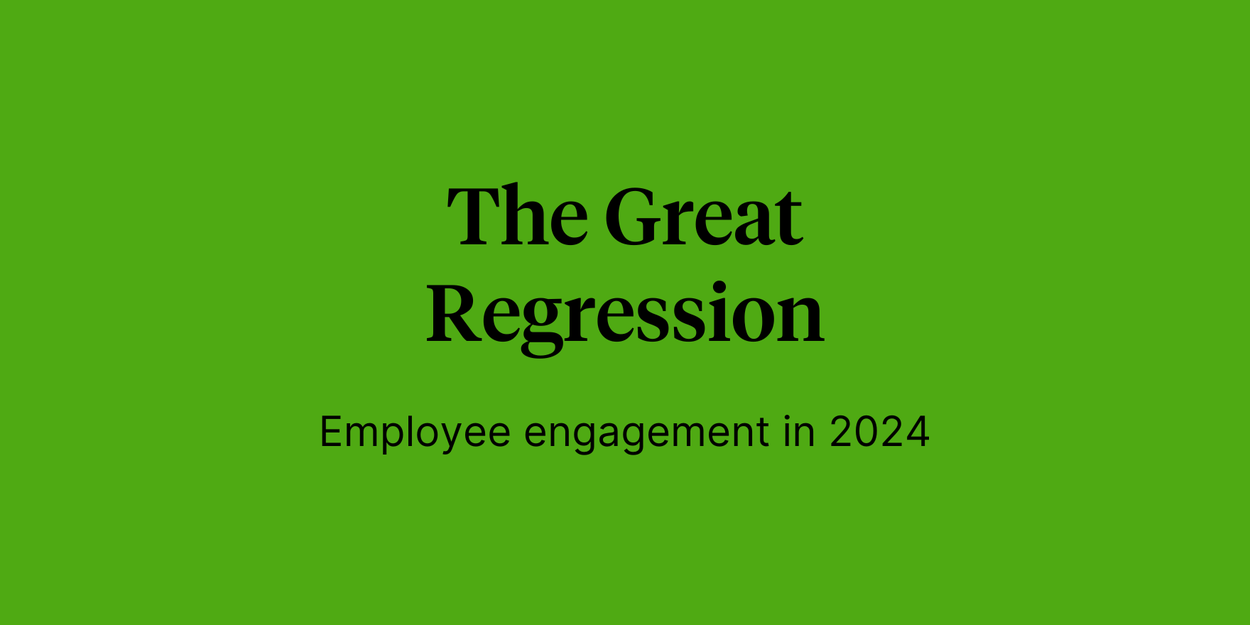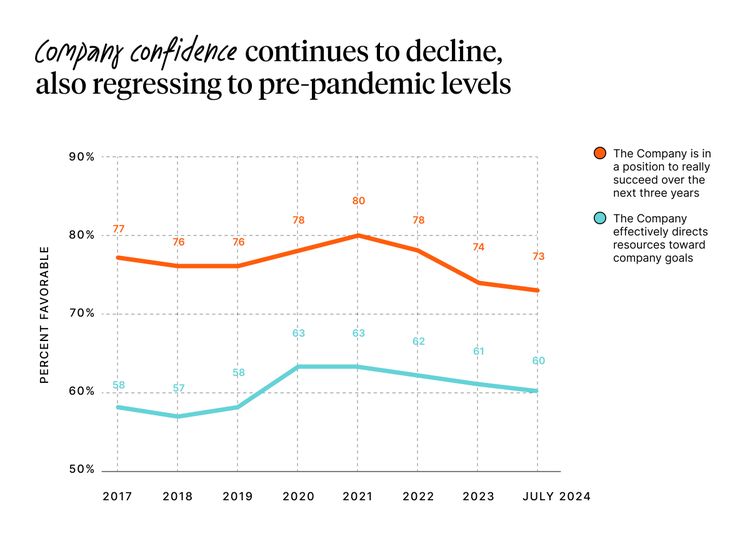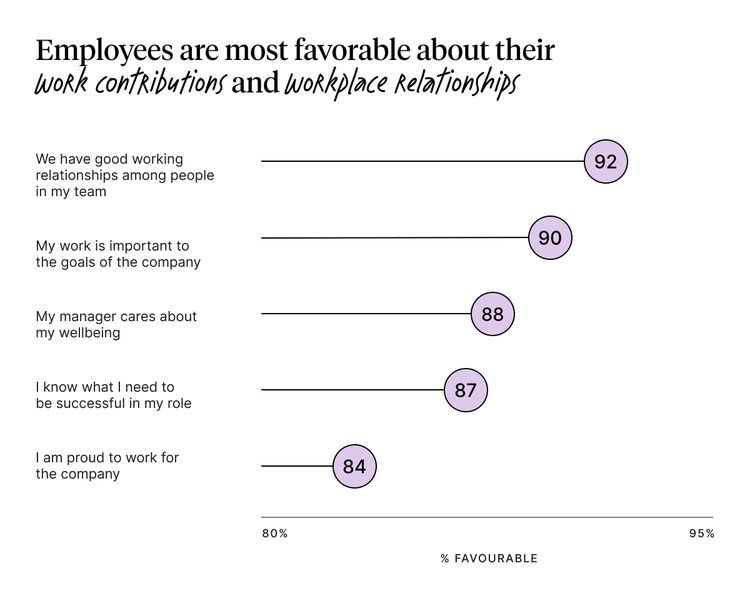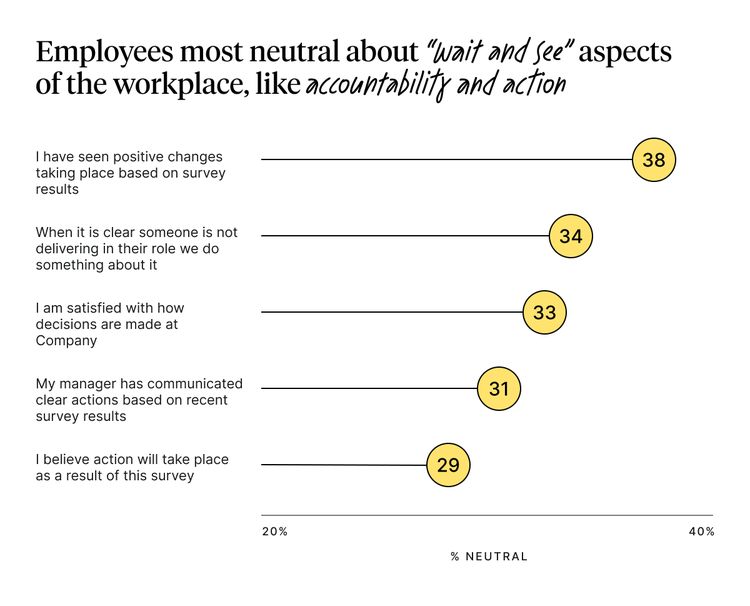
The Great Regression: Employee engagement in 2024

Written by

Senior Data Journalist, Culture Amp

Director of People Science Research, Culture Amp
The world of work is always in a state of flux, but something about 2024 feels different. We're not just talking about the usual ebb and flow of HR industry trends, but a genuine shift in what employees expect and value. Perhaps this is the result of a new generation of employees coming in and another taking leave via retirement, or perhaps it’s a regression following the “stronger together” boom of the pandemic. Employees may also simply crave stability after the overwhelming change of the past year.
At Culture Amp, we think of employee engagement as a psychological state made up of three core elements: enthusiasm for the company, motivation to go above and beyond, and commitment to stay. As we’ve done in previous years, we dove deep into our data lake to better understand what’s happening with employee engagement and its drivers in 2024.
So, what did we find?
If we were to get on the neologism train, we might call this employee engagement shift “the great regression.”
Globally, employee engagement has reverted to pre-pandemic levels, sitting at 71%. Meanwhile, the barrage of global events influencing this steady engagement level has been anything but static.

Over the last year, employees around the world have grappled with an onslaught of unknowns – economic uncertainty, AI disruption, ongoing wars, upcoming elections, DEI backlash, the ongoing shift towards hybrid work models, and more. Plus, employees have been dealing with these unknowns in the wake of the Great Resignation when the talent market was heavily in their favor. In 2024, the tables have turned.
While globally we’re seeing engagement level out, some countries are seeing the decline slowly continue, particularly in Europe.
When we separate the questions in our engagement index, we get a more detailed look at what has been happening with engagement over the last several years.

The decline in employee pride and motivation could stem from unfulfilled pandemic-era promises, as employees may feel that the benefits of flexibility and wellbeing are fading. As more companies have cut back on human-capital-focused resources, employees may feel less centered at work.
Engagement, on its own, gives us a pulse on employees’ psychological state. Typically, though, companies want to understand how to most effectively and efficiently influence engagement levels. To derive that, we look at drivers, or aspects of the employee experience that correlate to engagement.
Drivers of employee engagement have only gotten stronger
The top drivers of engagement have essentially remained the same and have become even stronger predictors of engagement over time. Those areas vary slightly by region but overlap globally across the top three drivers.

Confidence in leaders emerged as the top driver of engagement, which was surprising to us given the decline in companies asking employees about it – dropping from 54% in 2019 to only 37% in 2024. This decline suggests that some companies may be avoiding the topic, either due to concerns about the responses they might receive or because they are not prepared to allocate resources to address potential issues.
Nevertheless, the stability of core drivers is reassuring; it means the goalposts haven’t shifted. HR teams focused on these areas can proceed knowing that these broader focus areas are still likely to impact local engagement.
While top drivers have stayed the same, "I know what I need to be successful in my role" is climbing up the ranks as a driver of engagement. This suggests that clarity and support are becoming more crucial for navigating the current world of work.
Perception of leaders drops yet another percent in 2024
Also seeing a return to pre-pandemic levels are responses to questions about leadership. Since a big gain in 2020, we’ve seen a persistent decline in leadership perception, although the rate of decline is slowing.

This trend is likely influenced by a similar combination of factors we’re noting globally: ongoing economic uncertainty, the disruptive force of AI, waves of layoffs and RIFs, and so on. While these declines may not directly indicate eroding trust in leadership, they remind leaders to maintain the transparency, communication, support, and humanity that employees found so vital during the early pandemic.
Company confidence, which many employees perceive as an extension of leadership, has also taken a post-pandemic hit.

As for confidence that the company will succeed over the next three years, employee favorability has actually dipped below pre-pandemic levels – 3% lower than we saw in 2019 and 7% below its record high of 80% in 2021. Employees are likely looking both internally at their company and externally at the market as they answer this question. Challenges posed by inflation, supply chain disruptions, and shifting market demands can undermine confidence in their company's long-term success, though assessment of leadership undoubtedly plays a role.
In 2024, employees are most favorable when it comes to matters of the heart
Across what can feel like global chaos, we’re seeing that in 2024 employees are most favorable when it comes to matters of the heart: the meaning of their work, how it contributes to the company’s success, and their relationships with people on their teams. The parts where employees' lives are enriched through work are also the areas they agree are going most well.

Transactional aspects of work bring out the most disagreement from employees
On the flip side, employees respond most unfavorably (actively disagreeing) to survey items about transactions between them and the organization. This includes things like compensation, work-related stress, and workload.

The transactional aspects of work, such as compensation and workload, combined with the very human tendency to compare our situation to others, impact employee engagement. When employees perceive these factors as inequitable, they start looking for opportunities elsewhere, evidenced by the fact that one in five employees is thinking about looking for a job at another company.
Stress, compensation concerns, turnover intentions, and workload fairness are all factors that can drain employees' desire or ability to stay engaged at work. With 25% of employees worldwide feeling overstressed, it raises the question of who or what they hold accountable for their work-related stress. Are companies doing enough to address these concerns or inadvertently pushing their talent away?
Employees are most neutral about in-progress or developing aspects of their experience at work
In 2024, the parts of the employee experience that had employees most “on the fence” were those around action-taking and accountability.

Employees' neutral stance on certain aspects of their experience, seen as a hopeful pause, offers a unique insight into their mindset. By providing employees with the tools and guidance they need to thrive, companies can create a sense of control and purpose, even in the face of uncertainty.
The pandemic was a pivotal time, compelling employers and employees to face their vulnerabilities and reassess what truly matters. As a result, we glimpsed a future where workplaces are more engaged and purpose-driven. It was brief but illuminating, hinting at the potential for change. As we move forward, employees are not merely returning to old expectations; they are demanding a new era of transparency, humanity, and humility from their leaders. The challenge for organizations is to embrace this shift, fostering environments where trust and empathy become the cornerstones of a thriving workplace.

Get visibility into the real drivers of engagement at your company
About our data
To establish an understanding of employee engagement in 2024, we analyzed data collected from around 6,500 Culture Amp customers.
- We analyzed survey results collected between July 2023 and July 2024 and compared them to previously released benchmarks from 2017.
- For the July 2023 - July 2024 period, we analyzed survey results from 3 million employees from 4,738 companies.
To understand Culture Amp’s data and methodology in greater detail, explore the support pages for our survey templates and benchmarks, as well as our benchmark insights page.

